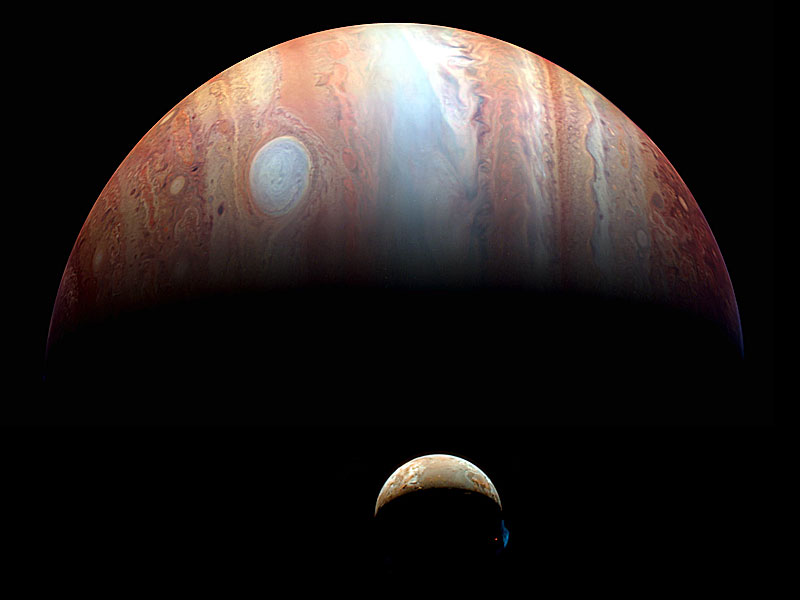Postpocelipse said:
when do the color cameras come online?
This is a problem I have with Rosetta and Dawn. Almost all the images from Rosetta, and of Vesta are greyscale.
This New Horizons montage of Jupiter and Io from 2008 is in colour. I assume the colour comes from the New Horizons camera.

There is a much larger version of this image.
The colour camera on New Horizons is called “Ralph”, I jest not.
More about Ralph on http://arxiv.org/ftp/arxiv/papers/0709/0709.4281.pdf
“Ralph combines panchromatic and color imaging capabilities with IR imaging spectroscopy. Other than a door opened once in flight, it has no moving parts.” – that’s good news! It means that ALL photographs taken by Ralph are in colour, rather than a system where a filter has to be moved manually from one setting to another.
Instead of Red/Green/Blue filters, Ralph has Blue (350-550 nm), Red (550-700 nm), Near Infrared (780-1100 nm) and Methane (860-910 nm).
Another camera on New Horizons is “LORRI”. Lorri is “a long focal length panchromatic CCD camera to provide 5x higher resolution imaging than Ralph could accomplish”.
Here’s an interesting thing, the science objectives of the New Horizons probe, from http://arxiv.org/ftp/arxiv/papers/0709/0709.4417.pdf
Group 1: Required
Characterize the global geology and morphology of Pluto and Charon
Map surface composition of Pluto and Charon
Characterize the neutral atmosphere of Pluto and its escape rate
Group 2: Highly Desired
Characterize the time variability of Pluto’s surface and atmosphere
Image Pluto and Charon in stereo
Map the terminators of Pluto and Charon with high resolution
Map the surface composition of selected areas of Pluto and Charon at high resolution
Characterize Pluto’s ionosphere and solar wind interaction
Search for neutral atmospheric species including H, H2, HCN, & CxHy, and other hydrocarbons and
Search for an atmosphere around Charon
Determine bolometric Bond albedos for Pluto and Charon
Map the surface temperatures of Pluto and Charon
Group 3: Desirable
Characterize the energetic particle environment of Pluto and Charon
Refine bulk parameters (radii, masses, densities) and orbits of Pluto and Charon
Search for additional satellites and rings
The Pluto system encounter will span ~200 days beginning in early 2015 and lasting until about 30 days after
Pluto closest approach. Complete data transmission, however, will require some 4 to 9 months after the
encounter owing to the 1000 bit/sec downlink rate at Pluto.
Near closest approach, RALPH will obtain maps of Pluto and Charon with km-scale resolution; at closest
approach, LORRI images at scales as high as 25 m/pixel may be achieved (depending on the final flyby
distance selected). In addition, the Group 1 objectives call for mapping the surface composition and
distributions of major volatile species, for which RALPH will obtain: (i) four-color global (dayside) maps
at 1.6 km resolution, (ii) diagnostic, hyper-spectral near-infrared maps at 7 km/pixel resolution globally
(dayside), and at 0.6 km/pixel for selected areas. Maps of surface-lying CH4, N2, CO, CO2, and H2O
abundances will be obtained. Surface temperatures will be mapped by RALPH using temperature-sensitive
IR spectral features; these maps are expected to have resolutions as good as 2 deg K and 10 km;
hemispheric-averaged surface brightness temperature will also be measured by the REX radiometer mode.
Characterization of Pluto’s neutral atmosphere and its escape rate will be accomplished by: (i) ALICE
ultraviolet airglow and solar occultation spectra to determine the mole fractions of N2, CH4, CO and Ar
to 1% in total mixing ratio and to determine the temperature structure in the upper atmosphere, (ii)
REX radio occultations at both Pluto and Charon, measuring the density/temperature structure of
Pluto’s neutral atmosphere to the surface, (iii) SWAP and PEPSSI in situ determination of the
atmospheric escape rate by measuring Pluto pickup ions, and (iv) ALICE H Lyα mapping of Pluto and
Charon in order to determine the rate of Roche-lobe flow of atmosphere from Pluto to Charon.
Searches for atmospheres around Charon and KBOs will be made using ALICE with both airglow and
solar occultation techniques.
REX-derived Doppler tracking will also be used to measure the masses of Pluto and Charon, and to
attempt J2 determinations; together with imagery-derived 3-D volumes, these data will be used to obtain
improved densities. SDC will measure the density and masses of dust particles in the solar system from 1
AU to at least 40 AU, far surpassing the 18 AU boundary beyond which any dust detector has as yet
penetrated.
Approximately three weeks after the Pluto closest approach, New Horizons will perform a trajectory
correction maneuver to target its first KBO encounter.


